Shipping has come a long way in the last few centuries, helping maritime companies become more efficient and profitable. What innovations have helped them meet deadlines and modern supply chain demands? Intermodal containers (ISOs) are among the most crucial inventions for the industry, reducing costs and improving sustainability for businesses worldwide. What are ISO containers, and how does this vital shipping tool work?
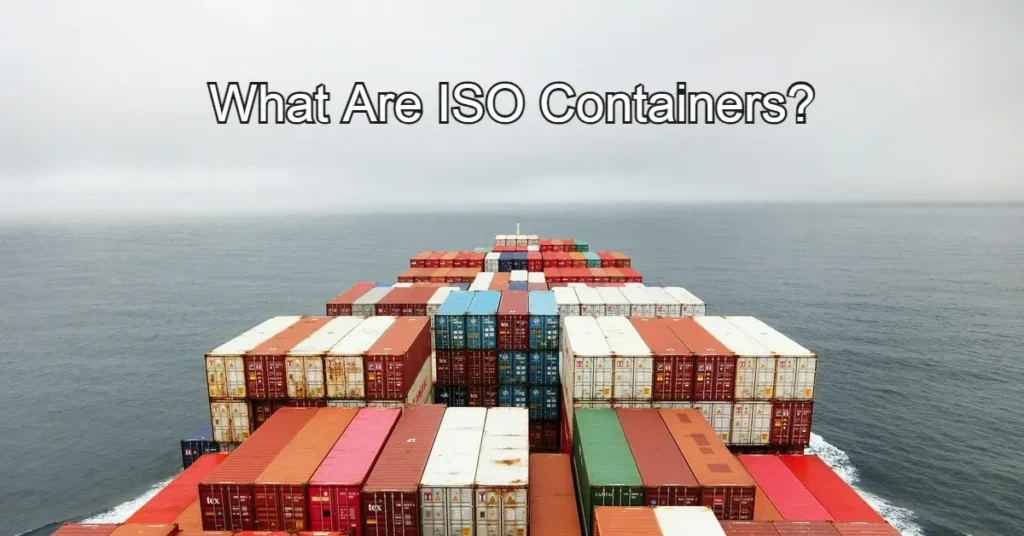
What Are ISO Containers?
Intermodal containers are large rectangular boxes typically found on cargo ships, but people can also see them on long-haul trucks and trains. They include many materials that companies ship domestically or internationally and have become integral to the modern supply chain. ISO containers are what numerous businesses rely on for their international commerce needs.
The abbreviation comes from the International Organization for Standardization — a nonprofit group based in Switzerland. It determines the size and other essential requirements for intermodal containers, paving the way for international standards on shipping.
Maritime professionals often use the ISO’s guidelines for classifying their containers by weight, dimensions and class. These shipping boxes can come in varying sizes, so selecting the correct one and complying with regulations is critical. Most businesses use ISO containers 20 feet or 40 feet long and 8 feet wide.
What Are ISO Containers Made From?
Intermodal containers travel long distances, so their composition is critical to ensure all items remain intact throughout the trip. Contact with water is expected among shipping containers, so the boxes must be durable to withstand strong currents and storms.
Most ISO containers contain corrugated weathering steel, also known as Corten steel, despite the risk of rust. Steel rusts easily due to iron combining with oxygen on the surface, but Corten steel’s oxidation gives it an advantage. Ships use it because it weathers and forms rust for protection instead of deterioration. Containers use the rust as a protective coating to prevent further oxidation and create a patina.
Most intermodal containers use Corten steel for its long-lasting qualities and extraordinary corrosion resistance. Research says about 1.95 billion metric tons of cargo ships annually, increasing the demand for top-of-the-line materials. Besides Corten steel, some shipping containers may use stainless steel or insulated panels, depending on the contents of each box.
How Many Types of ISO Containers Are There?
Shipments follow the rectangular prism shape but can vary in size and the contents inside. Some intermodal containers have unique features depending on what they’re transporting. Here are eight types that maritime companies see on their boats.
Dry Storage or General Purpose Containers
Dry storage is the most common type of ISO container. It carries general items that don’t need ventilation to stay cool during the trip overseas.
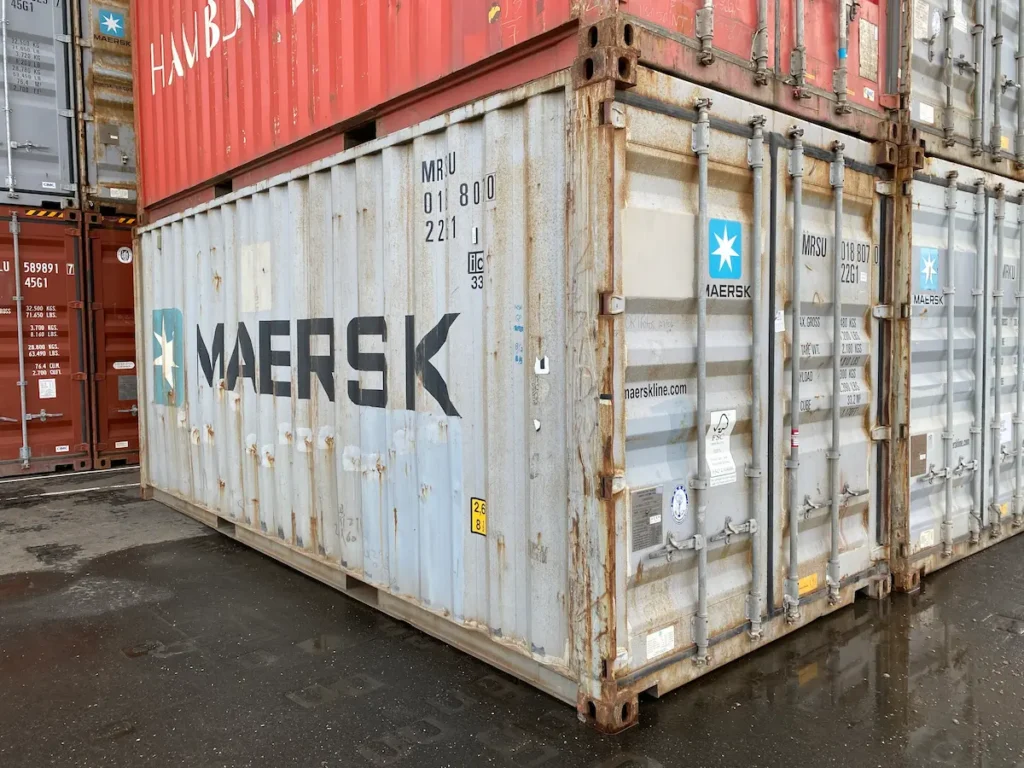
The shipments inside are typically dry, such as electronics, building materials, and clothing. Small dry storage containers are as small as 10 feet long but can expand to 40 feet if necessary.
| ISO Code | Description |
|---|---|
| 20 ft Dry Containers | |
| 22G0 | The 22G0 is a 20’x8’x8’6″ general purpose container with passive vents for minimal ventilation. |
| 22G1 | The 22G1 is a standard 20’x8’x8’6″ general purpose container, widely used for various cargoes. |
| 40 ft Dry Containers | |
| 42G0 | The 42G0 is a 40’x8’x8’6″ general purpose container with passive vents, suited for cargo needing minimal ventilation. |
| 42G1 | The 42G1 is a standard 40’x8’x8’6″ general purpose container, ideal for a wide range of cargo. |
| 40 ft High Cube Dry Containers | |
| 45G1 | The 45G1 is a 40’x8’x9’6″ high cube general purpose container, offering extra vertical space for taller cargo. |
| 45 ft and Longer Dry Containers | |
| L5G1 | The L5G1 is a 45’x8’x9’6″ high cube general purpose container, providing additional length for more cargo capacity. |
| L5G0 | The L5G0 is a 45’x8’x9’6″ high cube general purpose container with passive vents, ideal for longer cargo needing ventilation. |
| P5G1 | The P5G1 is a 48’x8’x9’6″ high cube general purpose container, suitable for extensive cargo requiring extra length. |
| P5G0 | The P5G0 is a 48’x8’x9’6″ high cube general purpose container with passive vents, for longer cargo that needs minimal air flow. |
| R5G1 | The R5G1 is a 53’x8’x9’6″ high cube general purpose container, providing maximum cargo space for extensive transportation needs. |
| R5G0 | The R5G0 is a 53’x8’x9’6″ high cube general purpose container with passive vents, for very long cargo requiring some ventilation. |
Flat Rack containers
Flat-rack containers are among the most unique on ships because of their setup. These capsules have no roof and two empty sides, creating a U-shape.
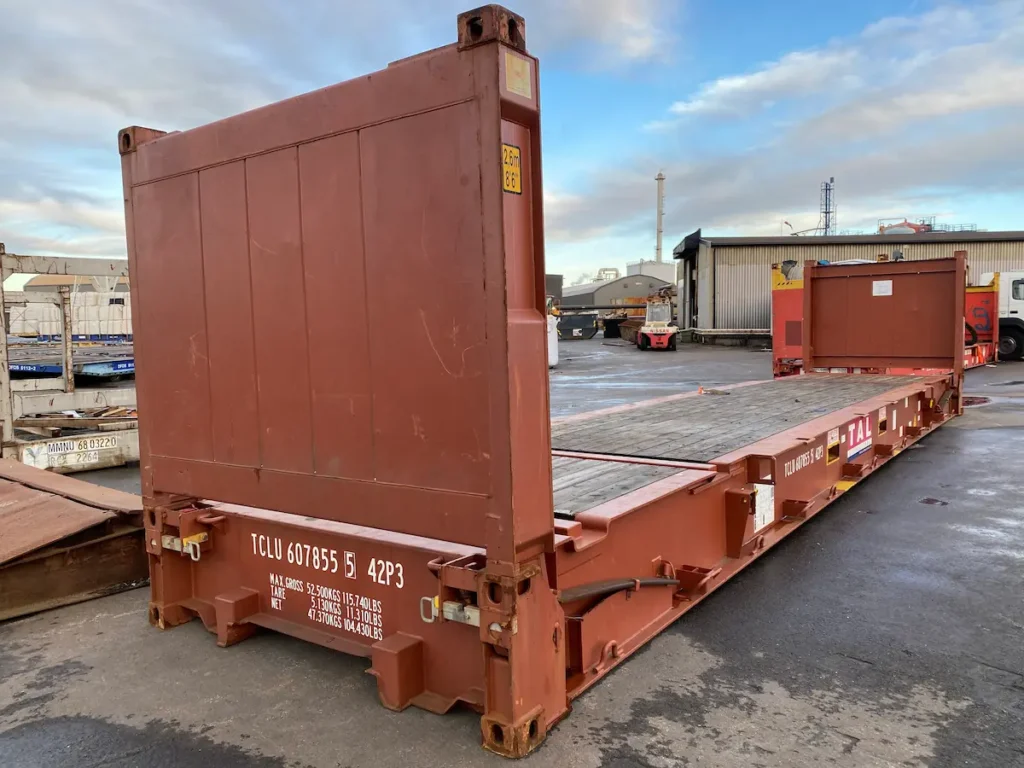
Flat-rack freights are ideal for heavy machines unsuitable for a typical container. Additionally, these containers may carry tall materials that would not fit with a roof over them.
Long pipes, beams, and wood are a few construction materials for a flat-rack mechanism.
| SO Code | Description |
|---|---|
| 20 ft Flat Rack Containers | |
| 22P1 | The 22P1 is a 20’x8′ flat rack container, ideal for heavy loads and oversized cargo that cannot be loaded into standard containers. |
| 22P3 | The 22P3 is a 20’x8′ folding flat rack container, designed for easy storage and transportation of heavy and oversized cargo. |
| 40 ft Flat Rack Containers | |
| 42P1 | The 42P1 is a 40’x8′ flat rack container, suitable for very large or heavy cargo that requires more space than a standard container. |
| 42P3 | The 42P3 is a 40’x8′ folding flat rack container, providing convenient storage and transportation solutions for exceptionally large or heavy loads. |
| 40 ft High Cube Flat Rack Containers | |
| 45P1 | The 45P1 is a 40’x8′ high cube flat rack container, offering extra height for taller cargo, ideal for heavy machinery and large items. |
| 45 ft and Longer Flat Rack Containers | |
| L5P1 | The L5P1 is a 45’x8′ flat rack container, extending the length for even larger cargo, suitable for exceptionally long or bulky items. |
| P5P1 | The P5P1 is a 48’x8′ flat rack container, designed for oversized cargo requiring additional length beyond standard container sizes. |
| R5P1 | The R5P1 is a 53’x8′ flat rack container, offering the maximum available length for transporting extremely large or heavy cargo. |
Tank containers
Tank containers are among the most crucial because they carry liquids, gases, and powders for various uses.
Companies store hazardous and nonhazardous materials inside these tanks, so caring for them is critical due to the risk of chemical spills and flammability.
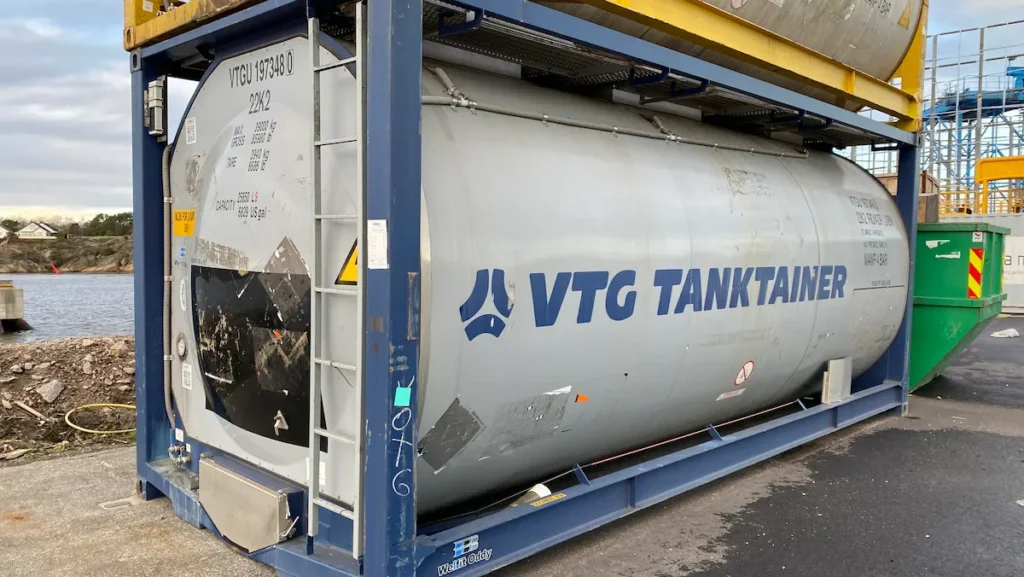
These capsules typically contain steel and don’t fill to reduce the risk of leaks. Thermal expansion is necessary or devastating problems could occur.
| ISO Code | Description |
|---|---|
| 20 ft Tank Containers | |
| 22T1 | The 22T1 is a 20’x8’x8’6″ tank container with a minimum pressure of 0.4 bar, suitable for non-hazardous liquids. |
| 22T2 | The 22T2 is a 20’x8’x8’6″ food-grade tank container, designed specifically for transporting food products. |
| 22T3 | The 22T3 is a 20’x8’x8’6″ tank container with a minimum pressure of 1.5 bar, ideal for hazardous or volatile substances. |
| 22T4 | The 22T4 is a 20’x8’x8’6″ high-pressure tank container with a minimum pressure of 2.65 bar, for highly volatile chemicals or gases. |
| 22T5 | The 22T5 is a 20’x8’x8’6″ high-pressure tank container with a minimum pressure of 4.0 bar, designed for aggressive or high-pressure substances. |
| 22T6 | The 22T6 is a 20’x8’x8’6″ tank container with a minimum pressure of 6.0 bar, suitable for very high-pressure liquids or gases. |
| 22T7 | The 22T7 is a 20’x8’x8’6″ tank container with advanced thermal insulation, ideal for temperature-sensitive cargo. |
| 22T8 | The 22T8 is a 20’x8’x8’6″ cryogenic tank container, designed for extremely low temperature liquids like LNG or liquid nitrogen. |
| 40 ft Tank Containers | |
| 42T1 | The 42T1 is a 40’x8’x8’6″ tank container with a minimum pressure of 0.4 bar, for larger volumes of non-hazardous liquids. |
| 42T3 | The 42T3 is a 40’x8’x8’6″ tank container with a minimum pressure of 1.5 bar, suited for larger quantities of hazardous or volatile substances. |
| 42T5 | The 42T5 is a 40’x8’x8’6″ high-pressure tank container with a minimum pressure of 4.0 bar, for bulk transport of high-pressure or aggressive substances. |
| 45 ft and Longer Tank Containers | |
| L5T1 | The L5T1 is a 45’x8′ tank container with a minimum pressure of 0.4 bar, extending capacity for non-hazardous liquid transportation. |
| P5T1 | The P5T1 is a 48’x8′ tank container with a minimum pressure of 0.4 bar, designed for large-scale transport of non-hazardous fluids. |
| R5T1 | The R5T1 is a 53’x8′ tank container with a minimum pressure of 0.4 bar, offering maximum volume for transporting large quantities of liquids. |
Refrigerated containers
Refrigerated containers are another critical piece of equipment because they transport items needing cold temperatures.
The internal temperature is typically at or below freezing because they carry meat, medicine, and other products that would spoil if they became too warm.
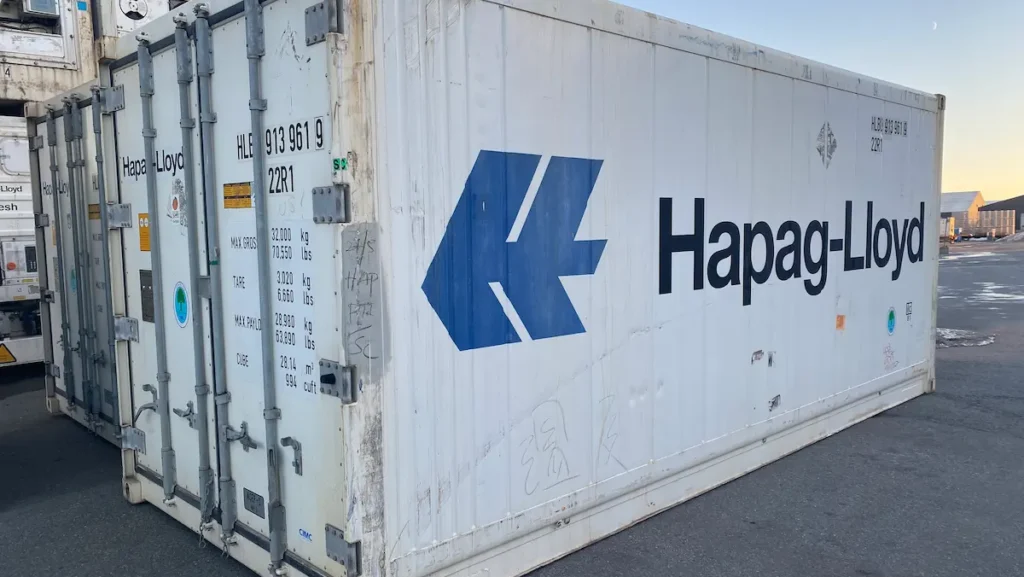
Refrigerated containers feature controllers — a special technology letting professionals control the temperature and ensure quality — and are heavier than standard dry storage because of their contents.
| SO Code | Description |
|---|---|
| 20 ft Refrigerated Containers | |
| 22R1 | The 22R1 is a 20’x8’x8’6″ refrigerated container, mechanically refrigerated for temperature-sensitive cargo. |
| 22R2 | The 22R2 is a 20’x8’x8’6″ refrigerated container, capable of both refrigeration and heating for precise temperature control. |
| 22R3 | The 22R3 is a 20’x8’x8’6″ refrigerated container with advanced insulation, designed for deep frozen or chilled goods. |
| 40 ft Refrigerated Containers | |
| 42R1 | The 42R1 is a 40’x8’x8’6″ refrigerated container, providing large-capacity, mechanically refrigerated storage for perishable goods. |
| 42R2 | The 42R2 is a 40’x8’x8’6″ refrigerated container with both cooling and heating capabilities, ideal for long-distance transport of sensitive cargo. |
| 42R3 | The 42R3 is a 40’x8’x8’6″ refrigerated container with enhanced insulation, perfect for transporting frozen products over long distances. |
| 40 ft High Cube Refrigerated Containers | |
| 45R1 | The 45R1 is a 40’x8’x9’6″ high cube refrigerated container, offering additional height for taller temperature-controlled cargo. |
| 45 ft and Longer Refrigerated Containers | |
| L5R1 | The L5R1 is a 45’x8′ refrigerated container, extending length for more capacity, ideal for large volumes of temperature-sensitive goods. |
| P5R1 | The P5R1 is a 48’x8′ refrigerated container, designed for transporting large quantities of perishable goods that require controlled temperatures. |
| R5R1 | The R5R1 is a 53’x8′ refrigerated container, providing the maximum available space for refrigerated transport of perishable items. |
Open Top
Open-top shipping containers are similar to dry storage, except they don’t have roofs. While missing a top could be worrisome, open-top containers have this design to fit gigantic items. For example, companies use them to ship a heavy machine or other cargo that fits oddly inside the container. The absent roof also makes loading and unloading more manageable and efficient for employees.
| ISO Code | Description |
|---|---|
| 20 ft Open Top Containers | |
| 22U1 | The 22U1 is a 20’x8’x8’6″ open top container, ideal for cargo that needs to be loaded from the top or sides, such as heavy machinery. |
| 22U2 | The 22U2 is a 20’x8’x8’6″ open top container with removable top members, facilitating loading and unloading of oversized items. |
| 40 ft Open Top Containers | |
| 42U1 | The 42U1 is a 40’x8’x8’6″ open top container, offering more space for top-loading of large or awkwardly shaped cargo. |
| 42U2 | The 42U2 is a 40’x8’x8’6″ open top container with removable top elements, suitable for heavy and tall items that need crane loading. |
| 40 ft High Cube Open Top Containers | |
| 45U1 | The 45U1 is a 40’x8’x9’6″ high cube open top container, providing extra height for taller items that require top or side loading. |
| 45 ft and Longer Open Top Containers | |
| L5U1 | The L5U1 is a 45’x8′ open top container, extending length for larger items needing top or side loading. |
| P5U1 | The P5U1 is a 48’x8′ open top container, designed for extra-long cargo requiring accessible top loading. |
| R5U1 | The R5U1 is a 53’x8′ open top container, the largest available for accommodating very long or tall items with top loading necessity. |
Open Side
Open-side containers are another example of dry storage freight missing one end. This capsule has bifold doors, giving companies flexibility in which side to open. These containers are best for large materials that would have difficulty fitting in a typical box. The downside of open-side shipments is they are more susceptible to weather and are only used once.
| ISO Code | Description |
|---|---|
| 20 ft Open Side Containers | |
| 22H1 | The 22H1 is a 20’x8’x8’6″ open side container, ideal for loading and unloading wider or irregularly shaped cargo. |
| 22H2 | The 22H2 is a 20’x8’x8’6″ hard-top open side container, combining easy side access with protective overhead coverage. |
| 40 ft Open Side Containers | |
| 42H1 | The 42H1 is a 40’x8’x8’6″ open side container, providing more space for side-loading of large or bulky items. |
| 42H2 | The 42H2 is a 40’x8’x8’6″ hard-top open side container, suitable for taller or wider cargo requiring side loading and a protective top. |
| 40 ft High Cube Open Side Containers | |
| 45H1 | The 45H1 is a 40’x8’x9’6″ high cube open side container, offering extra height and side access for tall, large, or awkwardly shaped items. |
| 45 ft and Longer Open Side Containers | |
| L5H1 | The L5H1 is a 45’x8′ open side container, providing extended length for loading long items or those requiring spacious side access. |
| P5H1 | The P5H1 is a 48’x8′ open side container, designed for extra-long cargo needing side loading and unloading. |
| R5H1 | The R5H1 is a 53’x8′ open side container, the largest size available for accommodating very long items with the need for side loading. |
Double Door
Double doors are a modified version of dry containers with a pair of doors on each end to increase flexibility. Those responsible for loading and unloading can use either side for moving materials, which typically entail heavy construction materials and vehicles. Their double-sided feature maximizes convenience from ships to the end user, such as a construction site.
| ISO Code | Description |
|---|---|
| 20 ft Double Door Containers | |
| 22DD | The 22DD is a 20’x8’x8’6″ double door container, featuring doors at both ends for easy loading and unloading of cargo. |
| 40 ft Double Door Containers | |
| 42DD | The 42DD is a 40’x8’x8’6″ double door container, offering doors at both ends for more efficient access to large or bulky cargo. |
| 40 ft High Cube Double Door Containers | |
| 45DD | The 45DD is a 40’x8’x9’6″ high cube double door container, providing extra height and dual-end access for taller items. |
| 45 ft and Longer Double Door Containers | |
| L5DD | The L5DD is a 45’x8′ double door container, extending the length for longer cargo and featuring doors at both ends for easy access. |
| P5DD | The P5DD is a 48’x8′ double door container, designed for extra-long cargo with dual-end doors facilitating efficient loading and unloading. |
| R5DD | The R5DD is a 53’x8′ double door container, the largest size available, ideal for very long items needing access from both ends. |
Insulated
Like refrigerated boxes, insulated ISO containers must maintain their internal temperature to avoid compromising the items inside. Professionals use these capsules when expecting extreme temperatures because top-of-the-line insulation protects them from weather and moisture. The insulation may vary by container, but some use polyisocyanurate (PIR) because of its excellent thermal performance.
| SO Code | Description |
|---|---|
| 20 ft Insulated Containers | |
| 22H0 | The 22H0 is a 20’x8’x8’6″ insulated container, designed to protect sensitive cargo from temperature extremes without active temperature control. |
| 40 ft Insulated Containers | |
| 42H0 | The 42H0 is a 40’x8’x8’6″ insulated container, offering larger space for temperature-sensitive cargo, maintaining a stable internal environment. |
| 40 ft High Cube Insulated Containers | |
| 45H0 | The 45H0 is a 40’x8’x9’6″ high cube insulated container, providing extra height and insulation for taller items requiring temperature stability. |
| 45 ft and Longer Insulated Containers | |
| L5H0 | The L5H0 is a 45’x8′ insulated container, extending length for larger volumes of temperature-sensitive cargo, with enhanced insulation. |
| P5H0 | The P5H0 is a 48’x8′ insulated container, designed for extra-long cargo that needs to be protected from temperature fluctuations. |
| R5H0 | The R5H0 is a 53’x8′ insulated container, the largest available size, ideal for very long items requiring insulation from external temperatures. |
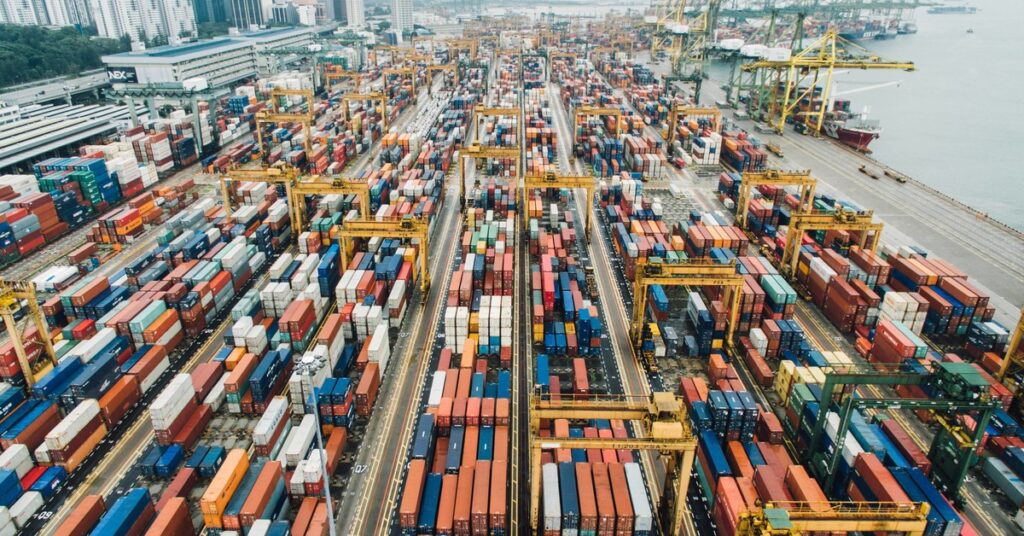
How to ISO Container Codes?
ISO container codes are alphanumeric identifiers that provide specific information about shipping containers. These codes are standardized by the International Organization for Standardization (ISO) and help in identifying the size, type, and features of containers used in international trade. The code is typically a combination of four parts: the first two digits, the third digit, the fourth digit, and a check digit.
How to Use the Tables:
- First 2 Digits – Container Length:
- This part of the code specifies the length of the container.
- Refer to the “First 2 Digits” table to determine the length of the container based on these digits.
- Example: A code starting with “22” indicates a standard 20-foot container.
- Third Digit – Container Height and Type:
- This digit provides information about the height and general type of the container.
- Use the “Third Digit” table to understand whether the container is standard height, high cube, refrigerated, open top, etc.
- Example: A “G” in this position indicates a general-purpose container.
- Fourth Digit – Type and Specific Characteristics:
- This digit further details the type of container and any special features it may have.
- Consult the “Fourth Digit” table to identify specific characteristics like ventilation, side door access, collapsible features, etc.
- Example: A “1” here typically means the container is a standard type without specific modifications.
First 2 Digits: Container Length
| Value | Length |
|---|---|
| 22 | 20 feet standard length |
| 25 | 20 feet, specific purpose (e.g., open-top, tank) |
| 42 | 40 feet standard length |
| 45 | 40 feet, specific purpose (e.g., open-top, tank) |
| 43 | 40 feet high cube |
| L5 | 45 feet standard length |
| P5 | 48 feet standard length |
| R5 | 53 feet standard length |
Third Digit: Container Height and Type
| Value | Height/Type |
|---|---|
| G | General purpose container |
| H | High cube container |
| R | Refrigerated container |
| U | Open top container |
| T | Tank container |
| V | Ventilated container |
| P | Platform container |
| B | Bulk container |
| S | Named cargo (e.g., livestock, automobile) |
Fourth Digit: Type and Specific Characteristics
| Value | Characteristics |
|---|---|
| 0 | Passive vents at upper part of the cargo space |
| 1 | Without any specific modifications or vents |
| 2 | Side door access |
| 3 | Folding (e.g., collapsible flat rack) |
| 4 | Ventilated with openings at top and bottom |
| 5 | Openings at one or both ends, plus removable top member in end frame |
| 6 | Openings at one or both ends, plus removable top members in end frames |
| 7 | Thermal container |
| 8 | Named cargo (e.g., livestock) |
| 9 | Other specific characteristics |
Examples of ISO Code Interpretation:
- ISO Code: “22G1”
- First 2 Digits (22): 20-foot standard length.
- Third Digit (G): General-purpose container.
- Fourth Digit (1): Standard type without specific modifications.
- ISO Code: “42H0”
- First 2 Digits (42): 40-foot standard length.
- Third Digit (H): High cube container.
- Fourth Digit (0): Passive vents at the upper part of the cargo space.
Important Notes:
- The ISO code structure can vary slightly depending on the manufacturer and the specific container.
- Always cross-reference with the manufacturer’s specifications for the most accurate information.
- The check digit is not included in these tables as it is a calculated number for validating the full ISO code.
What Are the Benefits of ISO Containers?
ISO containers are what most companies prefer because they’re the world’s standard. How have they become the premier choice? Here are six benefits that businesses see when using these superior capsules.
Sustainability
Sustainability has become a significant focus for industries worldwide, especially shipping and logistics. The Fourth Greenhouse Gas Study 2020 shows shipping has increased its CO2 emissions due to increased demand and energy consumption.
Research shows cargo ships account for 3% of global greenhouse gas emissions, so how have logistics companies tried to reduce their carbon footprint? ISO containers have a sustainability advantage thanks to their flexibility on sea and land.
Intermodal containers can stack on top of each other, making them easy to transport on ships and trains. Companies can move hundreds of containers simultaneously, lessening the need for individual trucks to move a single box. While trucks still carry containers, the industry uses boats and trains to heighten sustainability.
Durability
Ships may need a month or more to carry their cargo, traveling tens of thousands of miles before reaching the next port. Considering how treacherous the waters can be, each container must equip maximum durability to last the trip. Hurricanes can disrupt shipping lanes, sending 60-foot waves crashing onto the vessel. The vessels and containers must emphasize durability in their construction.
ISO containers are up for the task because of their superior constitution. Corten steel ensures each piece of equipment gets long-term use — unless it’s an open-side container. The advanced insulation and locking mechanisms make each box durable enough to last the entire trip until it can reach the next train or truck. The ships may use thick steel plates and strong framing to prevent ice damage while traversing cold waters.
Security
Theft is challenging to achieve at sea, but shipping containers are susceptible to break-ins when sitting at ports. Thieves may try to break into a box when port employees aren’t present, considering most aren’t open 24 hours daily. ISO containers combat theft using high-tech locks, security cameras, alarm systems, and other advanced technology to deter criminals and maintain structural integrity.
Efficiency
Transporting containers from one country to another requires boats, leading to a high demand for cargo ships. However, what happens when the shipment arrives at the port? Additional transportation is necessary to reach its final destination, making ISO equipment the most efficient choice.
Due to modern shipping standards, maritime professionals can quickly transfer intermodal containers to trains and long-haul trucks. The matching sizes and shapes make loading, unloading, stacking and transporting seamless between each stage, streamlining logistics and saving money.
The heightened efficiency makes ISO capsules the standard for shipping and the preferred choice for decades. The ease of use has trickled down to make the entire process more manageable. For example, suppose a flat-rack container arrives at a port. Employees will move the freight onto a lowboy trailer — typically 18 to 24 inches high — and send it to its next destination.
Design
How can ISO containers transfer easily from ships to trains and trucks? The design plays a significant role in their smooth transition from one phase to the next. The ISO’s standard dimensions help companies send containers from the United States to Switzerland, China, or South Africa with ease.
The design increases efficiency because loading and unloading only need to happen once. The same container can stay on the ship and travel by train or truck to its end-user without changing boxes unless something happens to the equipment — such as weather damage. Otherwise, the design is conducive to efficiency and durability for each trip.
Affordability
ISO containers are ideal for many businesses because of their affordability. Design improvements over the years have made them more accessible to companies on tight budgets. ISO equipment is convenient for organizations in the oil and gas industry, considering their other choices on the market.
If a company wants to find an ISO alternative, it can select a Det Norske Veritas (DNV) container. However, this equipment is much more expensive due to its unique design and materials needed for transportation. ISO containers remain more affordable due to stiff market competition, standardization and optimized design. Nowadays, a 20-foot container costs about $2,000 but can range from $1,000 to $3,500, whereas 40-foot containers can have a $4,500 price tag.
Employing ISO Containers to Meet Demand
Countries worldwide rely on cargo ships daily to bring supplies for their businesses. The modern supply chain demands maximum speed and efficiency in shipping, so companies rely on ISO containers in transportation.
These intermodal containers align with ISO standards to make shipping seamless worldwide and maintain structural integrity. The future of ISO containers may see tiny shifts, but shipping and logistics companies will likely use this equipment for a long time.
Frequently Asked Questions
Why is it called an intermodal container?
These containers get their name because of their variance in transportation. Companies place them on ships, trains, and trucks to reach their destination.
When did ships start using intermodal containers?
Malcolm McLean invented intermodal shipping containers in 1956 and changed how the world moves supplies. By 1968, the ISO listed its standards for boxes and made shipping much easier worldwide.
Why do intermodal containers have different colors?
The colors signify who owns a container and what people can find inside. For instance, refrigerated containers use white to maximize cool temperatures.
What country has the most shipping containers?
China leads the world in intermodal containers, boasting 262 million 20-foot equivalent units (TEUs) in 2021. The U.S. ranks in second place with 60.5 million TEUs.
What American ports see the most intermodal containers?
The Port of Los Angeles has the largest container volume in the United States, with 9.9 million TEUs in 2022. The Port of New York and New Jersey isn’t far behind, tallying 9.49 million TEUs.
- The Push to Reduce Cruise Ship Carbon Emissions in 2024 – July 19, 2024
- Marine Satellite Internet: How Ships Keep Connected – July 10, 2024
- What to Wear on a Boat – June 24, 2024




Leave a Reply